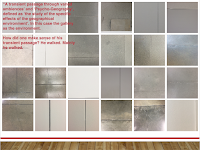Today's writing workshop was more of a re-cap on what is expected at the hand-in, how to submit and just ensuring all were fully aware. The below information relates to Unit 01: CRP and study plan.
Critical Research Paper:
500 word introduction - What is the project about and where are you to date.
MY PROJECT IS ABOUT . . . what has been done, existing practitioners and precedents and what is going to be taken further. It is a dialogue with others knowledge and ideas. How do your ideas fit in with others?
where bibliography is mentioned, this should include a list of all sources read to date. The same with the research folder. The research folder should be critically annotated and shown how it has be used [sources should be relevant]
Study plan:
Parts 1-3 to be completed [Other sections may be part filled]
there is no word count for the study plan and the document reads best as
a series of bullet points.
Context: Outline theory - Architects/ Designers/ Writers/ Theorists/ Processes
Outline major issues - field of study - research methodology - timetable [ October - Jan]
Method: Drawing / 3D models / Site visits / Artist Books [All work to lend itself to the concept of walking]
Both document will hold similar information and overlap. Both will give an area of interest/ case studies / research - previous work made and explored. Ensure that a real clear statement about your area/ topic/ issue/ question is made.
All work to be submitted via turnitin [online system that looks at
referencing %] Turnitin will also email recipients and receipt of proof
and a calculation of references used.
Submission
requirements - all work to submitted as a word/PDF and file titles should include name E.G.: FARDELL_SP and FARDELL_CRP
Deadline 11th January 2017 12:00pm
































